Acroyoga

Acroyoga (also written Acro-Yoga or Acro Yoga) is a physical practice that combines yoga and acrobatics.[1] Acroyoga includes many types of (mostly recreational) partner and group acrobatics in which at least someone is lifted. As such, it also draws on traditions of circus arts, cheerleading, and dance acro.
Acroyoga is more vigorous than many traditional forms of yoga as exercise and may lead to more injuries.[2]
Roles[]
There are three primary roles in an Acroyoga practice: base, flyer, and spotter.[3]
- Base - this is the individual who has the most points of contact with the ground. Often this person is lying on the ground with the entire back torso in full contact. This enables both the arms and legs to be "bone-stacked" for maximum stability and support of the Flyer. Main points of contact with the flyer are the feet (generally placed on the Flyer's hips, groin or lower abdomen) and the hands (which either form handholds or grasp the shoulders).
- Flyer - this is the individual who is elevated off the ground by the Base. The Flyer can move into a series of dynamic positions, and generally lets gravity do the work for them. A Flyer needs balance, confidence, and core strength.
- Spotter - this is the individual who has an objective view of the partners, and whose entire focus is on making sure that the Flyer lands safely in case of any slips. The spotter can also make recommendations to the Base and Flyer to improve their form.
Styles[]
There are two main styles in an Acroyoga practice: L-basing and Standing
- L-basing (includes "flows", "pops", and "whips") - the base usually lies on their back while supporting the flyer's weight on the bases legs (creating an L shape with the body). This style usually allows longer "flying" time.
- Standing - the base usually stands up and relays more on their hands and shoulders to support the flyer's weight. This style usually allows shorter "flying" time.
Elements[]

Acrobatics[]
is the physical part of Acroyoga that uses gymnastics techniques to build strength, flexibility, trust and teamwork between partners.
In the Acrobatic element we have:
Static poses[]
Initially basic poses such as bird, throne and whale. When the partners hold the position using equilibrium which is a state of rest or balance due to the equal action of opposing forces.
Acrobatic flying[]
Focus on movement - first, the flyer and base learn a static pose, later, how to move from one pose to another, creating a movement that is called "transition" in between the two poses.
In the acrobatic flying, there is a sequence of movements that start and end in the same position, which is called washing machine. There are many different washing machines. These basics washing machines that are taught are barrel roll and ninja star.
Pops[]
Small jumps where the partners keep physical contact with each other, usually keeping their hands connected.
Icarian Pops[]
Pops in which the flyer is thrown (and or jumps / kips) off of the base leaving no points of contact and then is typically caught once more.
Yoga[]
Reflects the physical, mental, and spiritual disciplines of yoga, in particular modern yoga as exercise.
Therapeutics[]

At AcroYoga Inc this includes Thai massage, therapeutic flying and partner yoga.
A basic therapeutic pose is Folded Leaf in which one partner is inverted and supported on the vertical legs of the other partner whose hands are then free for back massage.[4]
Therapeutic flying[]
The flyer relaxes the body and is guided by the base through some stretches and massage.
To help the flyer to relax, it is crucial to develop trust first, which can be done by practicing the acrobatic flying. Also, it is important that the base has a strong sense of responsibility, care and trust in all the movements that will execute, before start to heal flyers using therapeutic flying techniques.
It can use techniques from different types of massage, having as a result, a deep level of relaxation.
Learning AcroYoga[]

Learning Acroyoga requires strength training, flexibility training and technique training.[5] Strength training is accomplished through repetition of exercises like push-ups, hand walking and handstands. Flexibility training is best done at the end of a session with a partner. Learning good Acroyoga technique takes time and effort and is best learned with an expert teacher.[5] One important Acroyoga technique is called bone stacking. This involves the base partner keeping arms and legs straight to maximize the weight load on bones rather than muscles to support the flyer.[6]
A typical Acro Yoga session may include:[7]
- Circle ceremony promotes communication and openness
- Warm-up to gradually get your muscles ready for more strenuous exercise
- Partner flow - continue warming up with asanas and stretching with a partner[8]
- Inversions help build trust between the partners[8]
- Flying and acrobatics
Some communities have regular Acro Yoga meetings to provide a place for interested people to come together and practice for free, called jams. There are also larger Acro Yoga events such as the Dutch Acrobatics Convention, Acro SF, Vancouver Acro Festival, to name a few, that draw a global audience of practitioners.
All over the world, there are instructors teaching Acro Yoga in regular classes and workshops.
You can learn Acroyoga by yourself, but it takes time, discipline and responsibility, as you may not know all the techniques that will make the practice safe, for yourself and others.
Poses[]
There are many static acro yoga poses.[9] A series of acro yoga poses that are repeated in a continuous flow is called a Washing Machine.[10]
- Acro Yoga Poses

Front Bird - a basic acro yoga pose

Bird on one foot
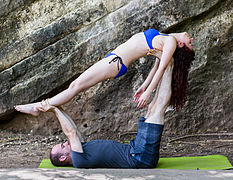
Whale
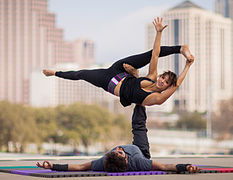
Hangle Dangle
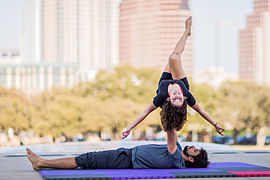
Back Bird variation
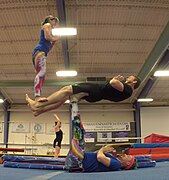
Three person balancing pose
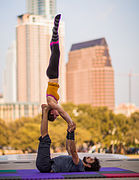
Star - side view
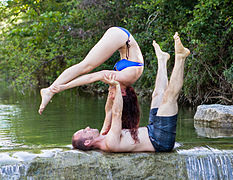
Floating Paschi

Throne Pose with base smaller than the flyer.
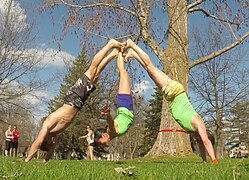
Non L-Basing pose
History[]
There are now many schools of AcroYoga. The original two schools were AcroYoga Montreal and AcroYoga Inc. AcroYoga Montreal was founded by Eugene Poku and Jessie Goldberg in 2003;[11] they had informally used the term AcroYoga since 1999.[12] Also in 2003, AcroYoga International was founded by Jason Nemer and Jenny Sauer-Klei in California USA.
This practice blends acrobatics, yoga and healing arts, with the focus initially mainly on therapeutic flying and yoga. Jason and Jenny were the first to codify the AcroYoga practice in 2006. They trained and made practice manuals for the public, trained teachers and still travel the world sharing the practice. By literally writing the book of AcroYoga, they unified the language between acrobats and yogis in different communities around the world. AcroYoga Inc. certified around a thousand AcroYoga teachers worldwide. The focus of the practice has shifted more to the Solar - acrobatic - part of AcroYoga.[11]
See also[]
References[]
- ^ Alpert, Yelena Moroz (5 April 2017). "10 Poses to Steal from Yoga Hybrids". Yoga Journal.
- ^ Smith, Eva Norlyk (23 March 2013), The Yoga Injuries Debate: How 'Dangerous' Is Yoga, Really?, HuffPost Healthy Living, retrieved 2 February 2014
- ^ Gates, Chee. "Extreme Yoga Poses and Positions". Fitness Magazine. Retrieved 29 April 2014.
- ^ "Partners In Play". Yoga Journal. Retrieved 29 July 2014.
- ^ a b Nemer, Jason and Sauer-Klein, Jenny. AcroYoga Flight Manual, 2008, acroyoga.org
- ^ "FIVE REASONS YOU SHOULD DO ACROYOGA". Pilgrimage of the Heart Yoga. Retrieved 29 July 2014.
- ^ "AcroYoga". Kula Movement. Archived from the original on May 13, 2014. Retrieved April 29, 2014.
- ^ a b Lee, Cyndi (November 2012). "Partner Up". Yoga Journal. Retrieved April 29, 2014.
- ^ "Poses – Alphabetized". acropedia.org. Retrieved 29 July 2014.
- ^ "Washing Machines – Alphabetized". acropedia.org. Archived from the original on 2013-07-18. Retrieved 29 July 2014.
- ^ a b Thomas, Buddy (19 July 2017). "The History of AcroYoga: Origin & Roots". Slackrobats.
- ^ "About Us". acroyogamontréal. Retrieved 29 July 2014.
External links[]
| Wikimedia Commons has media related to Acroyoga. |
- Physical exercise
- Yoga schools
- Acrobatic gymnastics
- Yoga hybrids











